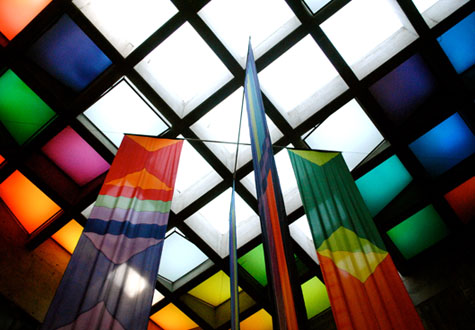Coming from a European background, I was very curious to see some of the artefacts that have been preserved in Canada. My trip to Brescia College was a journey into the past. Due to heavy rain that day, I preferred to take the shuttle bus rather than walk, and that's where it began. The dim, leather interior of the bus, the shelves along the top, the layer of dust ... if you were amongst the first students to attend Brescia, the bus wouldn't have looked much different from this one! I felt as if I was invited to the opening of the new college for girls in 1919 and I was starting my journey from a far away town. The outside atmosphere of the forested landscape and the pouring rain reminded me of such fictional characters as Jane Eyre travelling by coach.
But before I could get ahead of myself, the bus arrived to its destination (figure 1) and the jolly young voices of the new passengers awoke me from that reminiscence. Brescia College is not the same as it used to be at the time it was built. There is a new building now, featuring a modem design, unlike the Ursuline Hall where the Rose Room is located. Once I entered the Tudor Gothic style building through its massive oak door, I checked in with the receptionist, who didn't seem to place much significance on my visit to one a room filled with some of the oldest artefacts in London.
Brescia College was founded by the Ursuline Sisters as an institution for educating girls at the university level. It is amazing to realize just how much design goes hand in hand with social and moral values. The building and the Rose Room, despite the quite recent date of completion, features elements from the Gothic and Renaissance styles and stands out from the more modern parts of the university campus. The Rose Room houses a collection of found artefacts–some from antique shops in Stratford, others are gifts from around the world. The room forms a pretty portal to both the Gothic period and the beginning of the twentieth century, when this eclectic design style was favoured.
While attending such an institution, the young women could not help but develop a complete respect for others, proper organizational skills, manners in sitting, dining and conversation, and total faith. Moreover, there is inspiration to be found through the artwork and the decor in the Rose Parlour. Images of the Pope and a painting of Jesus Christ in the shape of the crucifix are featured as part of the design. These images are present in the Rose Room as if to remind the students to set high aims for themselves and to achieve them through hard work and dedication to God. The non religious ornaments in the room, such as the crocheted pieces, are created in a way that can only be achieved through precision and discipline in what is stereotypically seen as women's work. The crocheted pieces visualize patience.
I am used to living alongside palaces, and I knew that the noble families would often use colour to set the theme for specific spaces–the blue bedroom, the green study ...but a "rose room" in an institution such as a university college? Well, upon closer inspection, I realized that stripped bare of its antiques, the room would be nothing but a renovated dull room with peach walls with paint "sponged" on it and pinewood parquet. The rest of the features, obtained from so many sources, are a mismatch. Brescia College’s website contains a precise historical description of the origins of a number of the objects.
What interested me the most though, were the individual pieces found in the room. On top of the beautiful, floral fireplace, there are two oriental-styled vases. And though the vases fit neither the style nor the size of the room, their individual character and their colourful renderings add character and diversity to the otherwise very traditional space. The carved design of the fireplace seems too large and harsh compared to the miniature paintings on the vases. Another piece that spiked my curiosity is the Spanish writing desk. I was probably not supposed to touch, and especially open it, but I couldn't resist. It is unlikely that I will find myself at Brescia again, so I do not regret taking a peak!
Although the room never acquired a specific function, it is still used for formal lunch events and greeting new students. A doorway leads from the Rose Room to a small kitchen and the cabinets contain silverware and cocktail glasses. Its name is misleading by making the visitor believe, at first, that the room is intended for women only. When dining at the French table made of solid oak and leather, which has cracked with age, under a Medieval style chandelier, anybody can feel inspired by the Rose Parlour. It brings together virtue and faith in God through religious paintings and a bust of Joan D'arc. And I can imagine sitting on the rose-coloured cushions of the couches after long lectures is much more pleasant than the seats at the University Community Center or even the "comfortable" benches at the Visual Art Center! |













